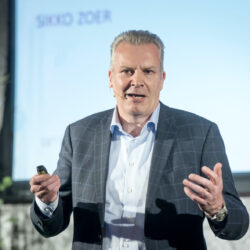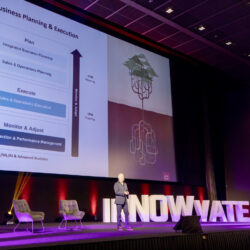Humans are the weakest link in self-driving, autonomous supply chains

The frontrunners in supply chain digitalization are busy creating self-driving supply chains, but the human brain cannot keep up with those developments. That was the conclusion of Sean Culey, author of Transition Point, at this year’s inNOWvate Supply Chain Event. “We won’t achieve autonomous supply chains until we dare to trust the new algorithms and their outcomes.”
By Marcel te Lindert
The global pandemic meant that many people were forced to spend more time at home. To combat the loneliness, more people than normal acquired a pet, which drove a rise in sales of dog food and cat food. “There’s no planning system in the whole world that could have predicted that in advance. It was triggered by a whole series of sequential developments that no one could have imagined,” said Sean Culey.
The author – whose book Transition Point is being added to Supply Chain Media’s new knowledge bank – cited the example to illustrate the challenges of the current times. He referred to the “waves of creative destruction” washing over the world, each spanning a period of 40 to 50 years. They all start with a period of experimentation and entrepreneurship and end with a period characterized by efficiency and exploitation. “We have just emerged from the previous wave and are now at the beginning of a new one. That is accompanied by uncertainty and unpredictability.”
Paradigm shift
In the previous wave, the supply chain emphasis was on low costs, but now that we are in the new wave companies are discovering that a cost focus has a downside. Globalization has resulted in more risks and longer lead times. Resilience has vanished from many supply chains, leading to numerous problems over the past 18 months. “The new wave is creating a paradigm shift. In the new wave, the customer is in charge rather than the company. We’re moving from a single channel with fixed costs to a combination of channels with flexible costs. We’re also moving from linear supply chains to circular ones and we’re increasingly selling services and experiences rather than products.”
Culey described how, in previous waves, manual labour was increasingly replaced by machines. Today’s machines are now so intelligent that they are performing ever-more tasks that have so far been done by the human brain. “We’re approaching the era in which the newest machines are smart enough to control the earlier machines. That will lead to automation of the entire end-to-end supply chain.”
Humans are too slow
The pandemic has accelerated these developments. According to Culey, consumers are behaving differently and have new wants and needs. Companies are responding to this with new business models. “We have to adapt our supply chains to this. Humans are too slow, our forecasts are not accurate enough and our planning cycles are too long to respond quickly to these developments. There will be a shift to cognitive software systems which will result in fully autonomous, self-driving supply chains where machines make the decisions and only report back to humans afterwards. Companies like Unilever, Merck and Johnson & Johnson are already working on this.”
The problem is that the amount of data and computing power is increasing, but the human brain can no longer keep up. Culey gave an example of planners who tend to adjust the outcomes of planning systems, but actually make the results worse rather than better. “We’re used to understanding how our systems work, but we’re now getting systems that we can no longer comprehend. We won’t achieve autonomous supply chains until we dare to trust the new algorithms and their outcomes.”
Digitalization is not an end in itself
Culey explained that he foresees a supply chain which offers more personalized products, services and experiences, which is more automated than ever and which is more localized than it is today. “This will lead to shorter, stronger and also more sustainable supply chains.” The necessary transformation poses challenges for companies, since the supply chain of the future requires a different mindset, different leadership and different approach to organizational management.
“The companies at the top of the Gartner Supply Chain Top 25 have three characteristics in common. First, they have an organization focused on long-term value creation rather than short-term profit optimization. Second, they are developing new, agile business models in which the supply chain plays a crucial role. And third, they are ‘digital directors’ who understand how to use digital technologies to keep the flywheel of those business models turning. That’s very important. Digitalization is not an end in itself, but a means to achieve the strategy. The question is, how can we use digitalization to formulate better value propositions and create better supply chains?” he concluded.










